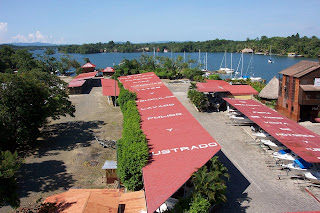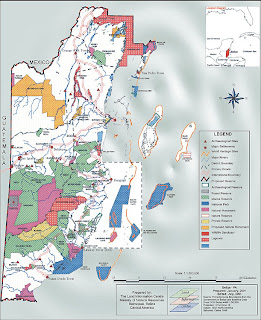Just as you are leaving the lower stretch of the river and just before you enter El Golfete, you will find Cayo Grande to starboard. Behind the cay is a lovely and well-protected anchorage, which you may have yourself, and there is a restaurant there for dinner (reservations recommended). The local businesses — and most everyone else along the river — monitors VHF Ch. 68.
As soon as you enter El Golfete a series of small bays stretch out to port. The last bay is affectionately known as Gringo Bay because it had been settled early on by a few hearty Americans who built modest homes on the bay accessible only by boat. Cruisers familiar with the area will tell you to stop in Gringo Bay and visit with a local fixture known simply as Jennifer.
Always welcome
Fitting in
 El Golfete is 10 miles long with water depths of 10 to 18 feet, depending on rainfall — almost up to its shores in most areas. There are many beautiful anchorages and the scenery in almost any direction is stunning. This is the home of Biotopo Chocon Machacas, which is a manatee reserve that covers the entire bay. The reserve also encompasses some 18,000 acres of land on the north side of the bay. Their purpose is to preserve the mangrove swamps and wildlife in the area. You may land your dinghy and visit anytime. The self-guided nature trails are a great way to spend a day. Expect to be asked to make a small donation of about five quetzals, or about 25 cents. The visit is well worth the price. You can virtually pull off to any side of the bay and drop anchor or settle in behind a few small cays along the northwestern shores depending on wind conditions. We rushed through here initially but returned later to spend some quality time.
El Golfete is 10 miles long with water depths of 10 to 18 feet, depending on rainfall — almost up to its shores in most areas. There are many beautiful anchorages and the scenery in almost any direction is stunning. This is the home of Biotopo Chocon Machacas, which is a manatee reserve that covers the entire bay. The reserve also encompasses some 18,000 acres of land on the north side of the bay. Their purpose is to preserve the mangrove swamps and wildlife in the area. You may land your dinghy and visit anytime. The self-guided nature trails are a great way to spend a day. Expect to be asked to make a small donation of about five quetzals, or about 25 cents. The visit is well worth the price. You can virtually pull off to any side of the bay and drop anchor or settle in behind a few small cays along the northwestern shores depending on wind conditions. We rushed through here initially but returned later to spend some quality time. Continuing across El Golfete you soon enter what is known as the Marina District. The river narrows and marinas are along both sides of the river. Unfortunately, this is about as far as most boats get after they arrive. If you arrive after mid-August, space at the marinas becomes hard to find.
Don’t expect to find U.S.-style marinas here. Almost all are set up for a Mediterranean mooring, or Med-moor, type of a tie up and not conducive to coming and going frequently. They are designed to cram as many boats as possible side by side. The process of getting in and out usually involves a day or two notice, a small boat or two to assist, and retying all your neighbors once you are out. There are no finger piers or pilings, with few exceptions, and the outer tie consists of lines run to something under the water. We could not find anyone to clarify for us just what that something is. Then you are tied in a crisscross fashion to your neighbors on both sides. Plenty of fenders are also required since, depending on where you are, the boat traffic and wakes can be constant and at times excessive. Since we had not been in a marina since Belize City we decided to stop and do some boat cleaning, laundry and a few other projects that are better done at the dock with electricity and water available.
 We soon found out that the rates at the marinas here are so cheap we would spend almost as much for fuel, charging batteries and heating water than we would to stay at the marina. So we took the plunge and paid for a month even though our plans were to only be here for a few weeks. But as every day went by it became more and more obvious that a few weeks were not going to be enough, and our stay would most assuredly be longer. We chose a marina that was recommended to us by our friends who were already there. There are several marinas in different locations along this stretch of the river to choose from, and the prices and amenities can vary quite a bit.
We soon found out that the rates at the marinas here are so cheap we would spend almost as much for fuel, charging batteries and heating water than we would to stay at the marina. So we took the plunge and paid for a month even though our plans were to only be here for a few weeks. But as every day went by it became more and more obvious that a few weeks were not going to be enough, and our stay would most assuredly be longer. We chose a marina that was recommended to us by our friends who were already there. There are several marinas in different locations along this stretch of the river to choose from, and the prices and amenities can vary quite a bit.
A walkabout ashore
 After we settled in and became familiar with our new locations, we set out to do some investigating of the area. Our marina sits directly under the large bridge that crosses the Rio Dulce between Fronteras and the small settlement of El Relleno. This bridge was built by the U.S. Army Corp of Engineers and completed in 1980. It stands 90 feet over the river. The mailing address for our marina literally translates from Spanish to “under the bridge.” An Internet café is directly across the street as well as the popular Reeds Tienda, a small grocery store that also stocks paint, boat parts and a variety of other products. If they don’t carry it, chances are good they will be able to get it for you in a short period of time. Chici has been the owner and operator for many years and most of the employees are family members.
After we settled in and became familiar with our new locations, we set out to do some investigating of the area. Our marina sits directly under the large bridge that crosses the Rio Dulce between Fronteras and the small settlement of El Relleno. This bridge was built by the U.S. Army Corp of Engineers and completed in 1980. It stands 90 feet over the river. The mailing address for our marina literally translates from Spanish to “under the bridge.” An Internet café is directly across the street as well as the popular Reeds Tienda, a small grocery store that also stocks paint, boat parts and a variety of other products. If they don’t carry it, chances are good they will be able to get it for you in a short period of time. Chici has been the owner and operator for many years and most of the employees are family members. The walk over the bridge to Fronteras on the other side of the river is a good workout and we learned early on not to do it in the middle of the day when the temperature can be brutal. You can also dinghy across the river and tie up at Bruno’s Marina or the town dock. Bruno’s is the preferred place to leave the dinghy since security can be an issue at the town dock, and the traffic from local boats coming and going can be damaging to small dinghies. This river is a main thoroughfare, and most facilities and homes are only accessible by water. At times of the day the boat traffic can remind you of being on a liquid freeway.
Pistols and livestock
Along the main street there are a number of tiendas or small grocery stores, restaurants, open-air produce markets and variety stores selling toys, pots and pans, and a number of different items. Except for the middle of the day, the town is bustling with people, and every shop and market is crowded. On certain days of the week the produce is brought in fresh and on those days the town becomes even more crowded. You can also find a couple of hardware stores as well as pharmacies and repair facilities in the town, but most are very basic.
They also have a few banks in town complete with armed guards standing inside and outside the front door, and a small room where you can check your gun before entering. After you complete your business your gun is then returned to you on the way out. This is a different world and lifestyle than we have been exposed to for most of our lives but we found it more fascinating than fearful.
In addition, there is a bus station that is a central hub for travel throughout the interior of Guatemala, and to Mexico and Honduras. Later we would use the bus system to explore and further sample what this wonderful country has to offer.
All of this and we have only been in the country for two days. Our heads were spinning, and with the endless possibilities before us it wasn’t long until we wondered out loud just how long we were really going to stay here. By the end of this day we were exhausted and happy and looking forward to what tomorrow would bring.












